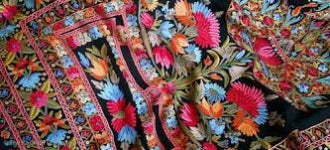
Pashmina Embroideries: The Exquisite Craftsmanship Unveiled
Share
Introduction
Pashmina, the epitome of luxury and elegance, has a rich history dating back centuries. Renowned for its unparalleled softness and warmth, Pashmina wool comes from the underbelly fleece of the Himalayan mountain goat, known as the Changthangi or Pashmina goat. However, beyond its luxurious texture lies another facet of Pashmina that truly sets it apart: the exquisite art of embroidery. In this blog, we delve into the world of Pashmina embroideries, exploring the intricate craftsmanship that adorns these timeless pieces of art.
Understanding Pashmina Embroideries
1. The Artistic Legacy

Pashmina embroideries trace their roots back to ancient times, where skilled artisans meticulously adorned fabrics with intricate designs. These embroideries were not merely decorative; they symbolized cultural motifs, religious beliefs, and social status. Passed down through generations, the art of Pashmina embroidery has evolved, blending traditional techniques with contemporary designs.
also read :- a detailed blog on what is pashmina embroidery ?
2. Techniques and Materials
The art of Pashmina embroidery encompasses a wide array of techniques, each requiring precision and skill. From the delicate chain stitch to the elaborate aari work, artisans employ various methods to create stunning motifs on Pashmina shawls, scarves, and wraps. Additionally, the choice of materials plays a crucial role in the embroidery process, with fine silk threads and metallic yarns adding luster and depth to the designs.
Exploring Exquisite Pashmina Embroideries
1. Kashida Embroidery

Kashida, meaning "to embellish" in Persian, is a traditional form of embroidery widely practiced in the Kashmir region. Characterized by its floral motifs and intricate patterns, Kashida embroidery adorns Pashmina shawls with timeless elegance. Artisans painstakingly create each stitch by hand, resulting in exquisite designs that exude opulence and sophistication.
2. Sozni Embroidery

Originating from the Persian word "suzan," meaning needle, Sozni embroidery is celebrated for its fine needlework and intricate patterns. Artisans skillfully embroider delicate motifs onto Pashmina fabrics using a single strand of silk thread. The result is a masterpiece of craftsmanship, with each stitch reflecting the artisan's expertise and attention to detail.
also read :- A detailed blog on An Ode of the Crafting of Sozni Pashmina
3. Aari Embroidery

Aari embroidery, also known as crewelwork, is characterized by its raised, textured motifs created using a hooked needle called an "aari." Artisans meticulously embroider elaborate designs onto Pashmina fabrics, incorporating traditional motifs such as paisleys, florals, and geometric patterns. Aari embroidery adds dimension and depth to Pashmina shawls, enhancing their beauty and allure.
also read :- A detailed blog on Aesthetic Pastels of Embroidered Pashmina
Preserving the Artistry
1. Artisanal Heritage
The art of Pashmina embroidery is not only a testament to craftsmanship but also a celebration of cultural heritage. By preserving traditional techniques and supporting artisanal communities, we ensure the continuation of this timeless art form for future generations to cherish and admire.
2. Sustainable Practices
In an age of mass production, embracing sustainable practices is crucial for preserving the integrity of Pashmina embroidery. By using ethically sourced materials and supporting fair trade initiatives, we can uphold the values of craftsmanship and sustainability, ensuring that each piece is imbued with the spirit of authenticity and tradition.
Conclusion
Pashmina embroideries stand as a testament to the timeless artistry and craftsmanship of the artisans who bring these exquisite designs to life. From the intricate motifs of Kashida embroidery to the delicate needlework of Sozni and Aari, each piece reflects the rich cultural heritage of the Kashmir region. As we celebrate the beauty of Pashmina embroidery, let us also recognize the importance of preserving this cherished art form for generations to come
visit :- https://www.pashwrap.com




